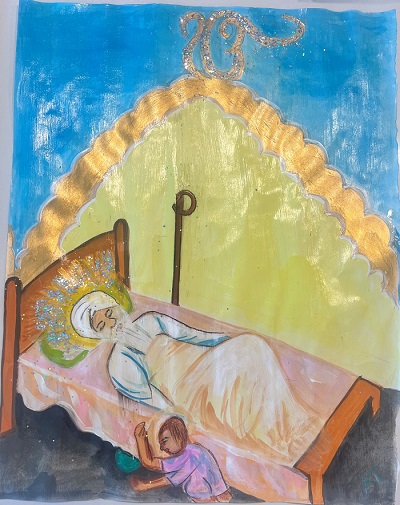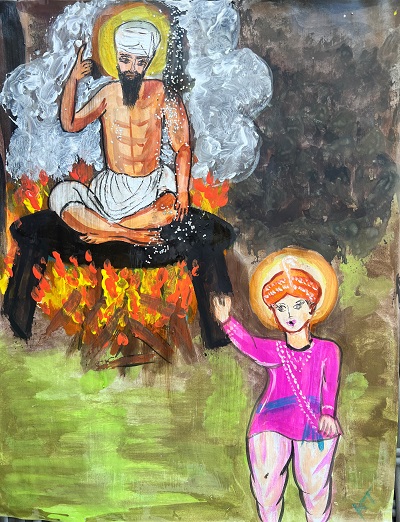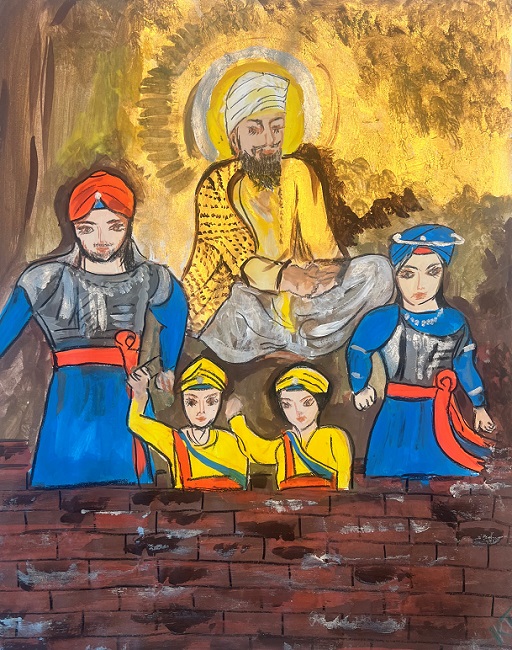Dec 07, 2025
Dec 07, 2025
A homage on Grandparents Day
 The Sikh Guru’s history is full of incidents that share the deep influence of grandparents in shaping the lives of their grandkids. The earliest such recorded history is how the company of Guru Amardas shaped the first eleven years of the life and character of child Arjan Dev. He was only 18 when he was anointed as the fifth Guru, succeeding his father, fourth Guru Ram Das. Guru Arjan was a scholar at heart with poetry in his veins, and was builder par excellence, a saint who became a martyr.
The Sikh Guru’s history is full of incidents that share the deep influence of grandparents in shaping the lives of their grandkids. The earliest such recorded history is how the company of Guru Amardas shaped the first eleven years of the life and character of child Arjan Dev. He was only 18 when he was anointed as the fifth Guru, succeeding his father, fourth Guru Ram Das. Guru Arjan was a scholar at heart with poetry in his veins, and was builder par excellence, a saint who became a martyr.
His contributions are magnificent as he helped in getting the Sarovar (lake) completed and then Darbar Sahib (also known as Golden Temple) built in the middle of Sarovar in Amritsar. Besides he was the compiler of Adi Granth, where his own 2313 compositions make him the single largest contributor. His composition of Sukhmani Sahib is considered as a soothing balm for troubled minds, providing solace and inner peace. It also inspires spiritual richness to the engrossed lives in the material world. He sacrificed his own life on principles thus setting a precedent with it. One such significant historical contribution to mankind can make a person immortalized, but he had four such outstanding contributions.
 Guru Arjan Dev Ji was born on 15 April 1563 to Father Guru Ram Das, the fourth Guru in Goindwal. At the time of his birth his maternal grandfather Guru Amardas was occupying the Gurgaddi as the third Guru. His early childhood of first 11 years were spent in Goindwal the seat of Guru Amardas, thus providing opportunity to be very close to him, cherish his love, affection, and guidance. As a result of this association, the personality of Guru Amardas cast a lasting influence on the mental and spiritual developments of the child Arjan Dev. When he was anointed as the fifth Guru on 01 September 1581, he was the first Guru to be born and raised in a family fully practicing the Sikh faith.
Guru Arjan Dev Ji was born on 15 April 1563 to Father Guru Ram Das, the fourth Guru in Goindwal. At the time of his birth his maternal grandfather Guru Amardas was occupying the Gurgaddi as the third Guru. His early childhood of first 11 years were spent in Goindwal the seat of Guru Amardas, thus providing opportunity to be very close to him, cherish his love, affection, and guidance. As a result of this association, the personality of Guru Amardas cast a lasting influence on the mental and spiritual developments of the child Arjan Dev. When he was anointed as the fifth Guru on 01 September 1581, he was the first Guru to be born and raised in a family fully practicing the Sikh faith.
One day, the little child Arjan of 4 or 5 was playing with a ball, which had slipped from his hand, bounced off on the floor and entered Guru Amardas’s room. Fully engrossed in his chase of the ball, the child Arjan went into the room and crawled under the bed where Guru Amardas was taking his afternoon nap. This sudden activity woke up Guru Ji who inquired what was happening? Hearing Guru Ji’s voice, Mother Mata Bhani rushed into the room and informed him that it was his grandson under his bed. It so impressed Guru Ji that he blessed the child with these words:
![]()
“Doahta bani ka Bohita”
Translation:
Grandson will be a great ship to carry the Word of God (Bani).
After this incident Guru Ji paid keen attention to child Arjan’s grooming and education. Guru Ji himself taught him Gurmukhi and made suitable arrangements to ensure that the best education in other fields was being imparted to him. Guru Ji also familiarized the child Arjan about the lives and teaching of his two predecessors Gurus. Guru Arjan compiled the Adi Granth during his tenure in August 1604, thus Guru Amardas Ji’s prophecy came true. Before embarking on this monumental task, Guru Arjan Dev Ji got the building work of Darbar Sahib (also known as Golden Temple) completed in 1601.
Any mention of Guru Arjan Dev Ji’s life will be incomplete without a mention of his martyrdom. Guru Ji became the first Sikh martyr in 1606. It is interesting to note that there was no original Indian language term for martyrdom, so the Sikh lore has incorporated the term “Shahadat” for it, borrowing it from its Arabic origin. The term “Shahadat” implies the supreme sacrifice one makes for one’s faith thus bearing witness to its truth coupled with a passionate adherence to it by giving life for it.
The emperor Jahangir was alarmed by the popularity of Guru Ji and was on a lookout for a pretext to arrest Guru Ji, torture him to death without dropping a drop of blood according to practice of “Yasa”. When his own son Khusro revolted against him and was provided with shelter by Guru Ji, he found the needed pretext. So, on his orders in the summer month of May 1606, Guru Ji was arrested and imprisoned in Lahore Fort. Later he was transferred to Chandu’s custody in his haveli in Mochi Bagh. He was first made to sit in the scorching sun on the hot sands, deprived of food and water. Next day he was made to sit in a boiling cauldron with burning fire under it. On the third day he was made to sit on a hot iron plate with burning fire under it, while hot sand was poured over his bare body, causing blisters, and burns all over. On 30 May 1606 he came to the bank of the river Ravi for his morning bath; he entered the waters but subsequently his body was never found. Gurdwara Dera Sahib, Lahore commemorates the spot of supreme sacrifice of Guru Arjan Dev.
Now let us see how Guru Arjan Dev Ji’s life and sacrifice inspired his grandson, the ninth Guru Tegh Bahadur. Guru Tegh Bahadur was born on 1 April 1621 to Father Guru Hargobind, the only son of fifth Guru Arjan Dev Ji and Mother Mata Nanaki. When Guru Hargobind came to visit the newborn child, he touched the feet of the child to the utter surprise of the onlookers. Bhai Bidhi Chand could not resist his curiosity and asked the reason for this unusual gesture. Guru Ji replied, “In him, my fifth son, I see the noble self-consecrating spirit of my father Guru Arjan.”
 Although child Tegh Bahadur did not get any chance of meeting his grandfather Guru Arjan Dev, still his upbringing was molded by it. The unique groundbreaking event martyrdom of Guru Arjan Dev in the country; had become the most talked about event. As this event happened in their family, naturally it came up in the family discussions, which the child Tegh Bahadur overheard and absorbed its magnanimity. When he turned 4-1/2, Father Guru Hargobind took him to Baba Budha Ji for formal education. Baba Ji had the privilege of spending considerable time with Guru Arjan Dev and upon completion of construction of Darbar Sahib was also its first appointed Granthi. Being a historical legend who had spent time with all the six Gurus, he enthralled child Tegh Bahadur with anecdotes from Guru Arjan Dev life as well as other Gurus. Later on, he was tutored by Bhai Gurdas in poetry and philosophy and by Bhai Bidhi Chand on the use of weapons and warfare strategies. All of his teachers had a very close personal association with Guru Arjan, and they would all share the anecdotes with him thus building in him a deep regard and reverence for Guru Arjan.
Although child Tegh Bahadur did not get any chance of meeting his grandfather Guru Arjan Dev, still his upbringing was molded by it. The unique groundbreaking event martyrdom of Guru Arjan Dev in the country; had become the most talked about event. As this event happened in their family, naturally it came up in the family discussions, which the child Tegh Bahadur overheard and absorbed its magnanimity. When he turned 4-1/2, Father Guru Hargobind took him to Baba Budha Ji for formal education. Baba Ji had the privilege of spending considerable time with Guru Arjan Dev and upon completion of construction of Darbar Sahib was also its first appointed Granthi. Being a historical legend who had spent time with all the six Gurus, he enthralled child Tegh Bahadur with anecdotes from Guru Arjan Dev life as well as other Gurus. Later on, he was tutored by Bhai Gurdas in poetry and philosophy and by Bhai Bidhi Chand on the use of weapons and warfare strategies. All of his teachers had a very close personal association with Guru Arjan, and they would all share the anecdotes with him thus building in him a deep regard and reverence for Guru Arjan.
When Mian Mir from Lahore visited Guru Hargobind in Amritsar, all Guru Ji’s children were in attendance to welcome him. Mian Mir shared with the family members the details of the precious sacred moments that he got to spend with Guru Arjan Dev in Lahore and Amritsar along with highlights of spiritual discourses that he had with him. For Guru Arjan the tortures that he was subjected to were as per God’s will and he bore them willingly terming them “ever so sweet”. Watching Mian Mir carry on with his daily spiritual practices zealously inspired child Tegh Bahadur with his own spiritual practices.
Mata Ganga, his grandmother, and wife of Guru Arjan Dev used to regale the child Tegh Bahadur with anecdotes from the life of her husband. She passed away in 1628, two months later his older brother by 2 years Baba Atal passed away. Baba Atal was just 9 when he left this world, which again deeply touched Tegh Bahadur. He learnt the supreme lesson of life that it requires a greater moral and spiritual courage to abide by the Will of the God, than to perform a miracle. In 1631, Baba Buddha passed away at age of 125, in Ramdas village leaving a void in the heart of the child Baba Tegh Bahadur. All these incidents left a deep mark on child Arjan’s psyche.
On 15 May 1628, a 7000 strong Mughals army under leadership of Mukhlis Khan attacked Amritsar, Guru Hargobind’s daughter Bibi Veero’s wedding was being celebrated. Guru Ji was forced to change his focus and prepare to face this unexpected onslaught. The Sikhs full of faith in Guru and in their enthusiasm to protect Amritsar offered a strong defense, foiling Mukhlis Khan’s efforts. Baba Tegh Bahadur eye witnessed the sorrowful cremation of dead after the battle, followed by the subdued celebration of his sister’s Anand Karaj wedding in Jhabhal very next day. The irony of happiness and sorrow being integral parts of life were thus firmly imprinted on Baba’s tender mind.
Guru Har Gobind with his family visited Tarn Taran in 1628, Baba Tegh Bahadur heard the details of supreme sacrifice of his grandfather Guru Arjan Dev Ji from the elders there, casting lasting imprints on him. From there the family went to Khadur, Goindwal gaining a rich first-hand exposure to two earlier Gurus’ lives and spiritual traditions. In Goindwal, Baba Sunder shared personal insights from the lives of Guru Amardas and Guru Arjan Dev Ji with the visitors. From all these sources Baba Tegh Bahadur gained an intimate knowledge about his grandfather, despite not having an opportunity to be with him in person.
In 1675 in Anandpur Sahib, the ninth Guru Tegh Bahadur Ji was visited by a delegation of 500 Kashmiri Pandits, led by Pandit Kirpa Ram, as head of Sanskrit Institution in Mattan, Kashmir. There they shared their deep plight of being forced to convert with Guru Ji. Guru Ji was considering all aspects of the situation in his mind, when his only son, young Gobind Rai walked after inquiry about the visitors he suggested Guru Ji sacrifice his life for their protection. Finally, Guru Ji asked Kirpa Ram to propose to Nawab that if Guru Tegh Bahadur accepts conversion, then all of them will follow suit willingly. In the meantime, Guru Ji set out from Anandpur towards Delhi for his sacrifice. Guru Ji laid down his life for the protection of Hindu faith on the afternoon of November 11, 1675, in Chandi Chowk, Delhi. Gurdwara Sis Ganj, opposite Red Fort, in Delhi commemorates the spot of his supreme sacrifice. There is no historical parallel in the world where someone gave his own life to protect the right of freedom of other’s faith, despite not practicing it himself. We can see here Guru Tegh Bahadur sacrificed his life upholding the tradition initiated by his grandfather.
Next let us look at his four grandchildren, the sons of his only son Guru Gobind Singh:
Name Date of Birth Day of sacrifice
1. Baba Ajit Singh January 26, 1687, December 22, 1704
2. Baba Jhujhur Singh March 14, 1691, December 22, 1704
3. Baba Zorawar Singh November 28, 1696, December 26, 1704
4. Baba Fateh Singh February 25, 1699, December 26, 1704
Baba Ajit Singh first tasted battlefield action at 13, inspired by his grandfather Guru Tegh Bahadur who first saw battlefield action when he was 14. On August 29, 1700, when the hill kings attacked the Taragarh fort, Baba Ajit Singh along with the other Singhs fought bravely, beating back the attackers. Next in October 1702 the joint forces of Wazir Khan and hill-kings attacked Nirmohgarh, Baba took the lead and fought vigorously beating back the attack, many soldiers from both sides were killed. Before the start of these battles, Guru Sahib had introduced both his elder sons to the tradition of martyrdom. Then again on 03 May 1704, Guru Ji found himself under siege laid by armies of Mughals and Hill-Chiefs. The Mughals attacked the Guru from one side and the Hill Rajas attacked them from the other side. The fighting continued fiercely for the whole day and at night until eventually the combined forces of the Mughals and Hill Rajas were exhausted and compelled to retreat. Then they decided to change the strategy and laid siege, cutting off all supplies.
Everyone holed in Anandpur had to endure deprivation and starvation as the siege lasted over 7 months with food and water supplies being totally cut off. During that siege Baba Ajit Singh held the command of Kesgarh fort, and Jujhar Singh held the command of Lohgarh fort. On the fateful night of 04 December 1704, Guru Ji with 1500 Sikhs evacuated Anandgarh, and while crossing River Sarsa they were attacked despite the promises of safe passage. Only 40 surviving members of the contingent reached Chamkaur and rest were either killed or lost. Holed up in the Chamkaur Garhi, and resting after the excruciating evacuation they were suddenly attacked upon by the Mughal army. The attackers were looking for the head of Guru Ji to take as a trophy for a handsome reward. The elder children, Baba Ajit Singh and Baba Jujhar Singh were amongst the 40 Sikhs with Guru Ji there. The Sikhs despite being severely outnumbered challenged them by coming out in batches of five, phased out from different locations and gave up their lives fighting gallantly to prevent the Mughal forces from running over the Garhi. Even the two Babas despite being underage sacrificed their lives in the battle of Chamkaur on 22nd December, fighting against the Mughal army, bent on finishing the legacy of the Sikhs. Gurdwara Katal Garh Sahib, Chamkaur commemorates the spot of supreme sacrifice of these two reverently called Sahibzadas.
Mata Gujri along with two younger Sahibzadas aged 9 and 7, had gotten separated from the rest during the evacuation from Anandpur were heading towards Morinda. They were met by an old retainer named Gangu, who promised them refuge in his house at his native village Saheri. Instead, out of greed for rewards, he handed them over to the Sirhind administration of Wazir Khan. The innocent young boys Sahibzada Zorawar Singh and Sahibzada Fateh Singh attained martyrdom on 27 December 1704, when they were brutally murdered by being bricked alive on the orders of Wazir Khan, the Mughal Governor. This was beyond a classic historical case of evil vs good, as the two Sahibzadas were just innocent children, but in their defiance, they sparked a yearning to be free, and able to choose their faith can be seen. These two youngsters showed indomitable courage, wisdom, steadfastness, and an unshakable faith beyond their tender ages.

Their faith convictions were bolstered by the inspiring stories of their grandfather’s sacrifice for the defense of the faith not practiced by him. Their grandmother had instilled in them this conviction of being true to their beliefs even at the cost of their own lives. For the first time in the history of the world, innocent children could not be enticed or persuaded by rewards or threats of torture and fear of death, or of future happiness, to abandon their glorious religion. In this way innocent children set an example of sacrifice for their religion and freedom. Gurdwara Fatehgarh Sahib, in Fatehgarh commemorates the spot of supreme sacrifice of two younger Sahibzadas.
In the above cases that we just examined we could see the imprint of indomitable courage, firmness to their faith, was blossomed in the grandkids from the stories of their grandfathers. They all sacrificed to uphold the principle that Guru Nanak Dev had preached. The following words on Guru Arjan Dev Ji’s lips at the time of his martyrdom capture it:
 “
“
Sunee aradaas suaamee merai sarab kalaa ban aaiee.
Pragat bhaee sagale jug a(n)tar gur naanak kee vaddiaaiee. 4.11.” – (SGGS, Pg. No. 611)
Translation:
My Lord and Master heard my prayer (as a devotee I took Lord’s shelter), and He filled me with strength to face all the excruciating circumstances. The glorious greatness of Guru Nanak is manifest, throughout all the ages. ||4||11||
As grandparents, we all want to inspire our grandchildren, and one of the best ways to do this is by sharing such stories of courage, conviction, faith, and bravery with them. May the grandkids become inspired by faith, Gurbani, and feel the Guru’s given strength to face the world’s daunting challenges. Let these words of Guru Amardas become their inner conviction:

“Peeuoo dhaadhe kaa khol ddiThaa khajaanaa.
Taa merai mun bhiaa nidhaanaa.” – (SGGS, Pg. No. 186)
Translation: When I opened it up and gazed upon the treasures of my ancestors (father and grandfather), then my mind became very happy. ||1||
Acknowledgement:
Special thanks to Kavita Tarneja (KT) for the special artwork to accompany the article.
References:
1. Jagdev, Santokh Singh. Bed Time Stories – 3: Guru Arjan Dev Ji. Sikh Missionary Resource Center. Birmingham. UK.
2. Singh, Harjit. Jeewan Yatra Tae Dharam Sidhant Guru Arjan Dev Ji (In Punjabi). Sikh Missionary College, Ludhiana.
3. Singh, Satbir. Sachitra Saheedi Parampara. SGPC, Amritsar.
4. Singh Dharam. Guru Arjan Dev. Punjabi University, Patiala.
5. Singh, Satbir, Gur Bharee: Jewanee Guru Hargobind Ji. Punjabi University, Patiala.
6. Singh, Dr. Trilochan. Guru Tegh Bahadur: Prophet and Martyr (a biography). Gurudwara Parbandhak Committee, Delhi.
7. Sarna, Jasbir Singh. Char Sahibzadas of Guru Gobind Singh. https://www.sikhnet.com/news/chaar%C2%A0-sahibzadas-guru-gobind-singh
8. http://www.indiandefencereview.com/the-story-of-sahibzada-zorawar-singh-and-sahibzada-fateh-singh/
02-Sep-2023
More by : Bhupinder Singh